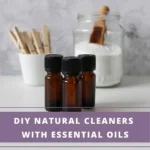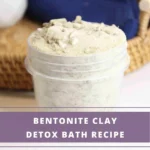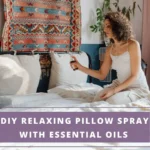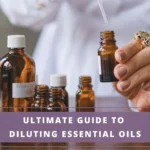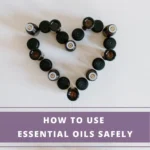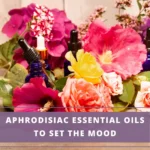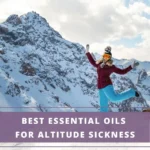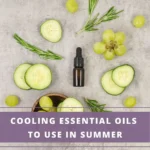As an Amazon Associate I earn from qualifying purchases. See Full Disclosure Here
Aromatherapy is the practice of using essential oils to promote physical and emotional well-being
Essential oils that are used in aromatherapy are highly concentrated extracts derived from the flowers, leaves, stems, or roots of certain botanicals. They contain the essence or aroma of the plant from which they are extracted. They also contain the plant’s healing ingredients.
Aromatherapy is based on the principle that aromas and oils of certain plants have powerful therapeutic properties. Used correctly, they can be used to enhance physical and psychological well-being.
 How Does Aromatherapy Work?
How Does Aromatherapy Work?
Experts suggest that inhaling the aromas of essential oils stimulates the olfactory nerves or smell receptors in the nasal passage.
The olfactory nerves send the scent molecules to the brain, where it activates the limbic system. This part of the brain is associated with emotions, memories, and behaviors. By stimulating the limbic system, essential oils help promote relaxation, reduce stress and anxiety, and enhance mood.
Another area that is impacted is the hypothalamus, which reacts to the molecules by producing feel-good hormones such as serotonin.
In addition to their effect on the brain, essential oils also have physical effects on the body. When applied topically, essential oils are absorbed through the skin and enter the bloodstream, where they can help to promote healing and reduce inflammation.
How Essential Oils Are Used In Aromatherapy
Aromatherapy using essential oils works via three pathways – inhalation, diffusion, and absorption through the skin.
Inhalation involves breathing in the aroma of essential oils directly from the bottle, from a personal inhaler, or using a steam bath. The scent molecules that enter the nasal passage activate the olfactory system, giving you the benefits of aromatherapy.
Diffusion refers to dispersing essential oils into the air through a diffuser. There are several different types of aroma diffusers. They work by releasing essential oil vapors gradually into the atmosphere. As you inhale the air around you, minute amounts of essential oil molecules enter your nasal passage.
Topical application involves applying diluted essential oils to the skin, in the form of aromatherapy massage oils, body lotions, or bath products. In this case, the molecules get absorbed through the top layer of the skin (epidermis). From there they move to the deeper layer of skin (dermis) and then to the blood vessels, which circulate them throughout the body.
Read: How To Use Essential Oils For Aromatherapy
What Are The Main Benefits Of Aromatherapy?
 The main benefits of aromatherapy are related to physical and emotional well-being. It is a complementary therapy that can be used in conjunction with other therapies to enhance their benefits.
The main benefits of aromatherapy are related to physical and emotional well-being. It is a complementary therapy that can be used in conjunction with other therapies to enhance their benefits.
Here’s a look at the 7 main benefits of aromatherapy with links to more detailed posts on each of the benefits:
1. Promotes relaxation: Aromatherapy is an effective relaxation technique that can help reduce muscle and mental tension, and promote a sense of calm. Go from stressed to zen with these essential oils for relaxation.
2. Reduces stress and anxiety: Inhaling the aroma of some essential oils has a calming effect on the mind and body, which can help reduce feelings of stress and anxiety. Unwind and de-stress at the end of the day with these stress-relieving essential oils.
3. Improves sleep: Some essential oils, such as lavender, chamomile, and sandalwood, are known to have a sedative effect. Inhaling the aroma of these oils can help promote better sleep. Fall asleep faster and stay asleep longer with these essential oils for sleep.
4. Enhances mood: One of the most well-known benefits of aromatherapy is its ability to enhance mood using the right essential oils.
5. Relieves pain: The best essential oils for pain have analgesic and anti-inflammatory properties. Topical application of these oils can provide tremendous relief from headaches, muscular inflammation, menstrual cramps, and chronic pain.
6. Boosts immunity: Essential oils such as tea tree, lemon, and eucalyptus have antimicrobial properties that can help boost the immune system and fight off infections. Some brands market synergy blends that contain a combination of immune-boosting oils. These are the best immunity-boosting essential oil synergy blends.
7. Improves cognitive function: Certain essential oils, such as rosemary and peppermint, are believed to have cognitive-enhancing properties that can help improve concentration and memory.
It’s important to note that aromatherapy is not a substitute for medical treatment. There are no studies that indicate that it can treat or cure any illnesses or medical conditions.
What studies do suggest is that aromatherapy could be used to support the conventional treatment of certain conditions. For example, it can be used to reduce pain, nausea, and muscular aches to make the symptoms more manageable.
It’s always advisable to consult with a healthcare professional before trying any new therapy.
How To Get The Benefits Of Aromatherapy
There are a number of ways you can use the sense of smell and skin absorption to get the benefits of aromatherapy. Click the links to read more details about each method.
– Diffuse essential oils
– Use essential oils in the bath
– Use essential oils in the shower
– Spritz an aroma room spray with essential oils
– Apply skincare products with essential oils
– Get an aromatherapy massage using aroma oils
– Use bath salts with essential oils
– Use a facial steamer for decongestion and sinus relief
– Wear aromatherapy jewelry for the benefits of essential oils on the go
– Buy a car essential oil diffuser for aromatherapy benefits while traveling
You can use two or more of these methods in combination to get the desired effect.
In addition to therapeutic benefits at physical and psychological levels, essential oils can also be used in several other applications. Some oils can be used to freshen up laundry while others with anti-microbial properties can be added to household cleaners.
Which Are The Best Essential Oils For Aromatherapy
There’s no single essential oil that’s best for aromatherapy in general. There are many different essential oils, each with its own unique properties and benefits.
The best essential oil to use for aromatherapy will depend on your individual needs and preferences. Some essential oils are known for their relaxing properties, while others are more energizing.
For example:
Lavender is the best essential oil for relaxation, stress relief, and sleep.
On the other hand, peppermint and lemon essential oils are known for their invigorating and energizing properties.
Citrus essential oils are often used to uplift mood and create a cheerful ambiance.
Tea tree and rosemary essential oils are commonly used for their antimicrobial and anti-inflammatory properties.
Important Things To Know About Buying Essential Oils For Aromatherapy
It’s important to choose high-quality, pure essential oils from a reputable source.
Make sure the label says ‘100% essential oils’. Avoid products with vague labels that say ‘Made with natural ingredients’ or ‘Made with essential oils ’ as these can be misleading. The product may have natural ingredients or essential oils but only in minute amounts. The larger proportion is likely to be synthetic fragrance oils. This product is not going to do anything for you. The label MUST say ‘made 100% essential oils or ONLY from natural ingredients or essential oils’.
There is a big difference between essential oils and fragrance oils. Both smell great but only essential oils have therapeutic properties. Fragrance oils are made from synthetic materials and do not offer any aromatherapy benefits other than a pleasant smell. Moreover, some can have negative side effects.
Make sure to take time and learn about using aromatherapy and essential oils correctly so you can enjoy their gentle healing benefits without any risks.
My top three essential oil brand recommendations for high quality at decent prices are:
All three brands also stock a range of fabulous body care and bath care products using essential oils.
Read: Ultimate Guide To Buying Essential Oils
Precautions When Using Aromatherapy
Aromatherapy is generally safe when used as directed. To minimize risks of potential adverse effects, it helps to adhere to these precautions when using essential oils:
Avoid using essential oils if you are pregnant or nursing. There are no conclusive studies on the effects of aromatherapy on pregnant or nursing women. It’s better to be on the safe side and avoid it altogether.
Always dilute essential oils with a carrier oil before applying to the skin. These highly concentrated extracts may react with your skin if applied directly without a carrier oil. Blending with a carrier oil doesn’t t affect the potency of the oil. Instead, it dilutes it and makes it safer to use. It also helps spread the oil more evenly over a larger area.
Some people have allergic reactions to certain essential oils. Before using topical aromatherapy, it’s a good idea to do an allergy test. Dilute 2 drops of essential oil in a carrier oil and gently apply to a small area on the inside of your forearm. Wait a few minutes and see if you have a reaction.
Although the FDA has published a list of essential oils that can be ingested, it’s best to avoid this altogether.
How To Get Started With Aromatherapy
The best way to get started with aromatherapy is to learn as much as you can about how aromatherapy works and which essential oils can be used for various healing purposes.
Armed with this knowledge you will have a better idea of which oils can help you get the aromatherapy benefits that you’re looking for.
Using an aroma diffuser may be the most popular way to use essential oils for aromatherapy, but it is not the only way. You can also use aromatherapy products such as bath and body care products and soaps.
To save money when you’re just getting started, buy an aromatherapy starter kit. With a starter kit, you’ll get a set of the most commonly-used essential oils at a fraction of the price. Some sets come with an aroma diffuser too.
Don’t jump in and start experimenting with all oils in the set right at the start. When you are just starting out it is a good practice to start with one or two essential oils. You can then expand your aromatherapy use.
These resources will teach you everything you need to know to get started with aromatherapy:
New To Aromatherapy? Things You’ll Need To Get Started
Types Of Essential Oil Diffusers For Aromatherapy
Ultimate Guide To Buying A Diffuser For Essential Oils
How To Use An Aromatherapy Diffuser
Best Essential Oil Books For All Levels
How To Store Essential Oils Correctly To Maximize Shelf Life
Busting The Myths About Aromatherapy And Essential Oils
Using Essential Oil – Cautions And Concerns
Understanding the basics will help you get the maximum healing benefits of aromatherapy without the adverse effects of wrongful use.
What Is Aromatherapy – FAQs
 Does aromatherapy really work?
Does aromatherapy really work?
Yes, aromatherapy really does work but only as a complementary therapy to improve overall well-being. It helps to improve mood, reduce stress, relieve pain, calm anxiety, and promote better sleep. However, it does not work to cure or treat medical ailments.
Is aromatherapy a new type of alternative therapy?
No, aromatherapy has been used for centuries by the Greeks, Romans, Egyptians, and Indians for various purposes. The practice of aromatherapy as we know it today was spurred by the research conducted by French chemist Rene-Maurice Gattefosse who coined the term “aromatherapie” in the 1920s.
Is aromatherapy safe?
Yes, aromatherapy is generally safe but those who have a history of allergies could have a bad reaction. Doing a quick and easy allergy test before topical application will confirm whether or not you’re allergic to any essential oils. And of course, never ingest essential oils.
Do I need to buy an aroma diffuser to get the benefits of aromatherapy?
No, an aroma diffuser is not mandatory for experiencing aromatherapy benefits. Check out these 25 ways to use essential oils without an aroma diffuser.
Does aro work for sleep?
Yes, absolutely! Using sleep essential oils is one of the most common uses of aromatherapy.
Does aro work for relief from stress and anxiety?
Yes, it does. The key is to use essential oils that are known to relieve stress and anxiety.
How can I get the benefits of aromatherapy when I’m outdoors and on the go?
There are two convenient ways to get the benefits of aromatherapy when you’re on the go. One is by carrying a portable essential oil inhaler in your purse or pocket. The second is by wearing an aromatherapy necklace or bracelet. Use a car diffuser to get the benefits of essential oils while driving.
 Disclaimer: This information is not intended to serve as medical advice. Please consult your physician before using essential oils. See Full Disclaimer here.
Disclaimer: This information is not intended to serve as medical advice. Please consult your physician before using essential oils. See Full Disclaimer here.


